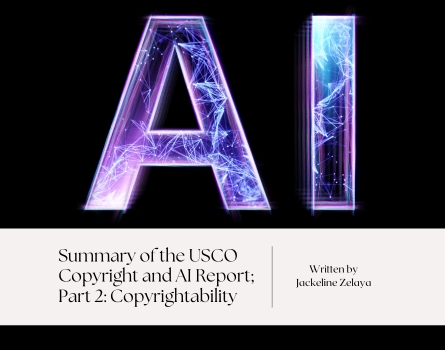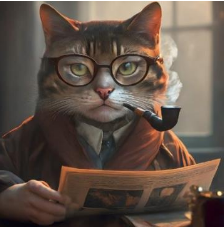Summary of the USCO Copyright and AI Report; Part 2: Copyrightability

On January 29, the U.S. Copyright Office released Part Two of its AI study, which analyzed issues surrounding the copyrightability of works that are partially or wholly generated by AI. Since the Copyright Office is responsible for examining registration applications, the copyright world eagerly awaited the Office’s analysis on AI copyrightability issues. Readers hoped to receive more clarity and insight into the Office’s analysis following the registration guidance it published in March 2023, which we covered in this previous blog post.
Unsurprisingly, the Office stood firm in its prior stances that: wholly AI-generated works are not protected by copyright; based on current AI technology, prompting an AI model does not alone provide sufficient control to constitute human authorship of AI generated outputs (which means that AI output generated solely by prompts cannot be protected by copyright); and copyright does protect elements where human authorship is expressed in the minimally creative selection, coordination, or arrangement of an AI-generated output or minimally creative modifications of AI-generated output.
But the Office did add nuance to its stance on AI copyrightability issues. It stated that it would register an AI-generated output where minimally creative works of human authorship used as inputs are perceptible in the output. Finally, the Office concluded that no additional copyright protections (sui generis rights) for AI generated outputs would be necessary at this time. Here are some of the key takeaways and the analysis from the Copyright Office’s most recent AI report on the copyrightability of AI outputs.
Copyright Only Protects Human Authored Expressions
As a threshold matter, the Office emphasized that copyright only protects works of human authorship and does not protect output that is wholly generated by AI models. The Office noted that the Copyright Clause in the U.S. Constitution grants Congress the authority to secure exclusive rights to human authors and cited to a variety of cases for support, including Burrow-Giles Lithographic Co v. Sarony and various Ninth Circuit cases involving claimed non-human authors like monkeys and spiritual beings. It noted that the district court for the District of Columbia had agreed with the Office in Thaler v. Perlmutter, where the Office had refused registration for an image that was wholly generated by an AI model. The court confirmed that the image was not protected by copyright because the Copyright Act only protects works of human authorship.
Turning to more nuanced AI applications, the Copyright Office noted that joint authorship copyright cases provided a helpful framework in understanding what kinds of human contributions in the AI context can amount to copyright-protected expression in AI-generated output. But the Office stressed that “there is an important distinction between using AI as a tool to assist in the creation of works and using AI as a stand-in for human creativity.” It then explored the scope of copyright protection for works containing AI-generated content in three contexts:
- when a human prompts an AI system to generate output;
- when a human inputs their own original work and prompts an AI system to generate output in which that work is perceptible; and
- when a human modifies an AI-generated output.
Prompting Is Not Sufficient Human Authorship
The Office concluded that, given current AI capabilities, prompting alone does not qualify as sufficient human authorship because a human cannot control the way an idea is expressed and executed through prompting. Thus, if a human had simply prompted an AI system to generate output, the Office reaffirmed its position that such output would not be protected by copyright. The Office was convinced by arguments and evidence that even though humans can engineer prompts to elicit more desirable results, including adding weights, adding details to the prompts, iteratively prompting, and other methods, generative AI systems always seemed to include or exclude content in the resulting output. To the Office, this demonstrated that the human prompter did not have sufficient control over how their ideas were translated and executed by an AI system, and so the resulting output lacked human authorship.
As evidence of this, the Office provided an example prompt and AI generated output to demonstrate how AI systems provide varying interpretations of human prompts and instructions, often filling in “gaps” in those instructions. In the example prompt, the Office specified a “bespectacled cat in a robe reading the Sunday newspaper and smoking a pipe” with other lighting and stylistic prompts which resulted in the AI-generated image below. Though the AI-generated image incorporated elements specified by the prompts, the Office noted that the image also contained elements not specified by the prompts such as the cat’s breed, coloring, size, pose, facial features and expression, an incongruous human hand, and clothes beneath the robe. The Office concluded that this exercise proved the point that human prompting alone cannot sufficiently control how the AI system processes the prompt in generating an output, and so prompting alone cannot result in copyright-protected human expression.

The Office rejected arguments that iterative prompting changes the analysis. The Office stated that iterative prompting is not sufficient human authorship as it resembles a “sweat of the brow” type of argument which was rejected by Supreme Court in the Feist case. The Office also rejected arguments that the protection of works featuring levels of randomness in the creation process, like in a Jackson Pollock painting, or if a wild animal stepped into a frame was analogous in the AI-context. The Office stated that for those copyright-protected works “the human author would still principally responsible for the execution of the idea and the determination of the expressive elements in the resulting work” and noted that “some element of randomness does not eliminate authorship.” The Office further stated that “[t]he issue is the degree of human control, rather than the predictability of the outcome.” Finally, the Office rejected the theory of “authorship by adoption” alone as a basis for recognizing AI prompting as sufficient human authorship because simply revising and resubmitting prompts until choosing an acceptable output is effectively just “re-rolling the dice” without altering the degree of control over the AI generation process itself.
Interestingly, the Office left the door open for a possibility where AI prompting might qualify as sufficient human authorship—that is if AI technologies are developed to where human prompting would closely control the expression in the resulting output without AI “filling in the gaps.” The Office noted that in those cases “a different conclusion may be called for.”
Expressive Inputs That Are Perceptible in AI-Generated Output May Be Protected By Copyright
The Office added nuance to its position about how prompting alone does not result in protectable human expression by stating that copyright would protect elements in an AI-generated output where human authored-expressive inputs are perceptible in the output. The Office found the argument convincing that human authors who use their own works as input to prompt an AI system “may have a greater claim to authorship” because “‘there is a limited range of specific expressive output that is objectively foreseeable as a result of a human user’s contribution’” as opposed to “simply applying ‘prompts to an unknown starting point.’”
To illustrate, the Office discussed the scope of copyright protections in the AI-generated image Rose Enigma. In Rose Enigma, visual artist Kris Kashtanova created a hand-drawn illustration and used it as input, along with text prompts. The Office noted that Kashtanova’s drawing itself was a copyrightable work, and that the expressive elements of that drawing were “clearly perceptible” in the AI-generated output, including “the outline of the mask, the position of the nose, mouth, and cheekbones relative to the shape of the mask, the arrangement of the stems and rosebuds, and the shape and placement of the four leaves.” The Office stated that just as the scope of copyright in derivative works is limited to the protectable expression added by the later author, “copyright in this kind of AI-generated output would cover the perceptible human expression.”
The Office noted that it granted the registration for the image since the applicant disclaimed the AI-generated elements including the realistic, three-dimensional representation of the nose, lips, and rosebuds and the lighting and shadow in the background. Future copyright applicants should take note of this example when trying to figure out what disclaimers are necessary when registering an AI-generated work containing perceptible expressive inputs. We expect the Copyright Office’s Compendium and Registration Guidance to be updated accordingly in the coming months.
Original Modifications and Arrangements of AI-Generated Output Can Be Protected
Consistent with the AI Registration Guidance in 2023, the Copyright Office affirmed that copyright would protect original (minimally creative) human expression that modifies or arranges AI-generated output. This includes the original selection, coordination, and arrangement of AI-generated outputs or other original modifications to an AI output. By way of illustration, the Office referred to its issuance of a registration certification for the comic book, Zarya of the Dawn, where the Office limited the scope of the registration for the compilation work to the human authored original selection and arrangement of AI-generated images and human authored text.
Copyright Office Does Not Recommend New Rights to Protect AI-Generated Output
The Copyright Office generally rejected the notion that changes in existing copyright law were necessary, pointing out that “the incentives authorized by the Copyright Clause are to be provided to human authors as the means to promote progress.” Some commenters had also argued that specialized rights, or sui generis rights, like a shortened term of protection for AI generated material were necessary to provide incentives for the creation of more AI generated works and for furthering progress in culture and knowledge to the benefit of the public. But the Office disagreed, sharing concerns expressed about the impact of AI-generated material on “human authors and the value that their creative expression provides to society,” noting that additional legal protections for AI-generated content would undermine rather than advance the goals of the copyright system.
Conclusion
The Copyright Office’s report on AI copyrightability issues mostly reaffirms the Office’s positions taken in its prior Registration Guidance. However, through its analysis in the report, the Copyright Office demonstrates that copyright law and its foundational principles remain flexible to address many tough questions about copyrightability in the context of AI. We hope that with further updates to the Compendium of U.S. Copyright Office Practices and with an updated registration guidance, human creators and rights holders will be able to confidently navigate the copyright registration process in the age of AI technologies and other future technologies.
If you aren’t already a member of the Copyright Alliance, you can join today by completing our Individual Creator Members membership form! Members gain access to monthly newsletters, educational webinars, and so much more — all for free!

